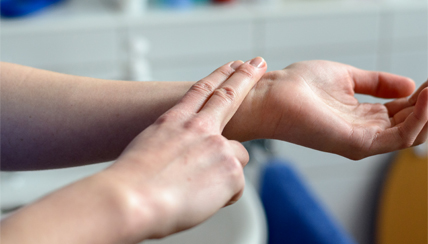How to Check Your Pulse
Checking Your Pulse During the COVID-19 Pandemic
 Your pulse changes as your body fights and recovers from an illness such as COVID-19. If you have a fever, your pulse is likely to increase. If your resting heart rate is higher than normal, you may have a fever. Monitoring your heart rate can help you detect symptoms of coronavirus early.
Your pulse changes as your body fights and recovers from an illness such as COVID-19. If you have a fever, your pulse is likely to increase. If your resting heart rate is higher than normal, you may have a fever. Monitoring your heart rate can help you detect symptoms of coronavirus early.
How to Check Your Pulse
Checking your pulse can help you understand how well your heart is working, how your body is responding to an adverse event, like getting sick, and can help determine your fitness level. Your pulse is measured by how many times your heart beats in one minute and can be easily measured on your own.
Your lowest pulse is your resting heart rate. A lower resting heart rate indicates a stronger heart muscle or higher level of fitness. Having a lower resting heart rate can help prevent cardiac events like a heart attack. A higher resting heart rate may indicate a problem with your heart or a lower fitness level. Having a higher resting heart rate can lead to illnesses like cardiovascular disease.
Average Heart Rates
- Babies: 100-160 beats per minute
- Children 1 to 10 years old: 60-140 beats per minute
- People 10 years of age and older: 60-100 beats per minute
The best time to check for your resting heart rate is right after you wake up in the morning. Do not take your pulse within two hours of exercise, stressful activity or drinking caffeine as your pulse may be higher and will not give you an accurate resting heartrate. Many smart phones and watches can check your pulse for you automatically. If you do not have a device, you can check your pulse by hand.
Taking Your Pulse on Your Wrist
Find a watch, clock, or timer on your phone set to count down the seconds in a minute.
Wash your hands with soap and water for at least 20 seconds and dry well.
Turn one hand over so that your palm is facing upward.
Place the tips of the index finger and middle finger of the other hand at the crease of the wrist below the base of the thumb.
Press down lightly with your index and middle finger until you feel blood pulsing under your fingers. You may need to move your fingers around slightly until you feel your pulse.
When you’re ready, begin counting the number of times you feel your pulse beat under your fingers for 30-seconds.
Multiply the number of beats you counted in 30-seconds times two.
That final number is your pulse.
Taking Your Pulse on Your Neck
Find a watch, clock, or timer on your phone set to count down the seconds in a minute.
Wash your hands with soap and water for at least 20 seconds and dry well.
Place the tips of the index finger and middle finger along either side of your windpipe, which runs down the middle of the front of your neck, right below your chin.
Press down lightly with your index and middle finger until you feel blood pulsing under your fingers. You may need to move your fingers around slightly until you feel your pulse.
When you’re ready, begin counting the number of times you feel your pulse beat under your fingers for 30-seconds.
Multiply the number of beats you counted in 30-seconds times two.
That final number is your pulse.
This information has been reviewed and approved by Carrie Horn, MD (April 2020)
| The information on our website is medically reviewed and accurate at the time of publication. Due to the changing nature of the COVID-19 pandemic, information may have since changed. CDC.gov and your state’s health department may offer additional guidance. |


